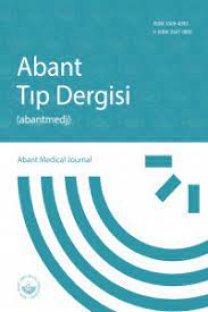Sars-Cov-2 Pandemisi Nedeniyle Geciktirilen Üreter Taşı Tedavisinin Klinik Sonuçları
SARS-CoV-2 Pandemisi, Üreter Taşı, Üreteroskopi, Komplikasyon
Clinical Outcomes of Ureter Stone Treatment Delayed Due To The Sars-Cov-2 Pandemic
SARS-CoV-2 Pandemic, Ureter Stone, Treatment, Complication,
___
- 1. Proietti S, Gaboardi F, Giusti G. Endourological Stone Management in the Era of the COVID-19. Eur Urol. 2020;78:131-133.
- 2. Stensland KD, Morgan TM, Moinzadeh A, Lee CT, Briganti A, Catto JWF, Canes D. Considerations in the Triage of Urologic Surgeries During the COVID-19 Pandemic. Eur Urol. 2020;77:663-666.
- 3. Tefik T, Guven S, Villa L, Gokce MI, Kallidonis P, Petkova K, Kiremit MC, Sonmez MG, de Lorenzis E, Eryildirim B, Sarica K. Urolithiasis Practice Patterns Following the COVID-19 Pandemic: Overview from the EULIS Collaborative Research Working Group. Eur Urol. 2020;78:e21-e24.
- 4. Gökce Mİ, Yin S, Sönmez MG, Eryildirim B, Kallidonis P, Petkova K, Guven S, Kiremit MC, de Lorenzis E, Tefik T, Villa L, Zeng G, Sarica K. How does the COVID-19 pandemic affect the preoperative evaluation and anesthesia applied for urinary stones? EULIS eCORE-IAU multicenter collaborative cohort study. Urolithiasis. 2020;48:345-351.
- 5. Ibrahim AK. Reporting ureteroscopy complications using the modified clavien classification system. Urol Ann. 2015;7:53-7.
- 6. Alevizopoulos A, Zosimas D, Piha L, Hanna M, Charitopoulos K. Managing Small Ureteral Stones: A Retrospective Study on Follow-Up, Clinical Outcomes and Cost-Effectiveness of Conservative Management vs. Early Surgery. Curr Urol. 2016;9:36-43.
- 7. Ficarra V, Novara G, Abrate A, Bartoletti R, Crestani A, De Nunzio C, Giannarini G, Gregori A, Liguori G, Mirone V, Pavan N, Scarpa RM, Simonato A, Trombetta C, Tubaro A, Porpiglia F; Research Urology Network (RUN). Urology practice during the COVID-19 pandemic. Minerva Urol Nefrol. 2020;72:369-375.
- 8. Stensland KD, Morgan TM, Moinzadeh A, Lee CT, Briganti A, Catto JWF, Canes D. Considerations in the Triage of Urologic Surgeries During the COVID-19 Pandemic. Eur Urol. 2020;77:663-666.
- 9. Tugcu V, Resorlu B, Sahin S, Atar A, Kocakaya R, Eksi M, Tasci AI. Flexible Ureteroscopy versus Retroperitoneal Laparoscopic Ureterolithotomy for the Treatment of Proximal Ureteral Stones >15 mm: A Single Surgeon Experience. Urol Int. 2016;96:77-82.
- 10. Raja A, Wood F, Joshi HB. The impact of urinary stone disease and their treatment on patients' quality of life: a qualitative study. Urolithiasis. 2020;48:227-234.
- 11. Ordon M, Schuler TD, Honey RJ. Ureteral avulsion during contemporary ureteroscopic stone management: "the scabbard avulsion". J Endourol. 2011;25:1259-62.
- 12. Somani BK, Giusti G, Sun Y, Osther PJ, Frank M, De Sio M, Turna B, de la Rosette J. Complications associated with ureterorenoscopy (URS) related to treatment of urolithiasis: the Clinical Research Office of Endourological Society URS Global study. World J Urol. 2017;35:675-681.
- 13. Boehm K, Ziewers S, Brandt MP, Sparwasser P, Haack M, Willems F, Thomas A, Dotzauer R, Höfner T, Tsaur I, Haferkamp A, Borgmann H. Telemedicine Online Visits in Urology During the COVID-19 Pandemic-Potential, Risk Factors, and Patients' Perspective. Eur Urol. 2020;78:16-20.
- 14. Micoogullari U, Kisa E, Yucel C, Ozbilen MH, Karaca E, Cakici MC, Ozcift B, Ilbey YO. The effect of the first wave of COVID-19 pandemic on urology practice and anxiety scores of patients awaiting surgery. Int J Clin Pract. 2021;75:e14201.
- 15. Hollander JE, Carr BG. Virtually Perfect? Telemedicine for Covid-19. N Engl J Med. 2020;382:1679-1681.
- 16. Stahel PF. How to risk-stratify elective surgery during the COVID-19 pandemic? Patient Saf Surg. 2020;31;14:8.
- 17. Fukushima H, Kobayashi M, Kawano K, Morimoto S. Performance of Quick Sequential (Sepsis Related) and Sequential (Sepsis Related) Organ Failure Assessment to Predict Mortality in Patients with Acute Pyelonephritis Associated with Upper Urinary Tract Calculi. J Urol. 2018;199:1526-1533.
- Yayın Aralığı: 6
- Başlangıç: 2012
- Yayıncı: Bolu Abant İzzet Baysal Üniversitesi Tıp Fakültesi Dekanlığı
Yürütücü İşlev Ölçeği: Bir Ölçek Uyarlama Çalışması
İzole Spontan Baziler Arter Diseksiyonu: Olgu Sunumu
Serdar ÖZDEMİR, Abuzer ÖZKAN, Hatice AKÇA, Abdullah ALGIN
Türkiyede Lokal Anestezi Alanında Yapılmış Lisansüstü Tezlerin Bibliografik Analizi
Emel YILDIZ, Halil YILDIZ, Sevil ALKAN, Özlem ARIK
Servikal Vertebral Aks Düzleşmesi: Demografi ve Nedenler
Sıçanlarda Bupropion ve Vareniklinin Morfin Yoksunluğu Sendromu Üzerine Etkileri
Oruç YUNUSOĞLU, Çagla KÖSE, Andleeb SHAHZADİ, Sibel ÖZYAZGAN, Bülent DEMİR, Burak ÖNAL, Ahmet Gökhan AKKAN
Sars-Cov-2 Pandemisi Nedeniyle Geciktirilen Üreter Taşı Tedavisinin Klinik Sonuçları
Çağlar YILDIRIM, Mehmet Yilmaz SALMAN, Mehmet Şirin ERTEK, Göksel BAYAR
Parotis Kitlelerinin Teşhisinde İnce İğne Aspirasyon Biyopsisinin Rolü
Ercan KURT, Mahmut ÇORAPLI, Safiye KAFADAR, Bilge AYDIN TÜRK, Koray TÜMÜKLÜ
